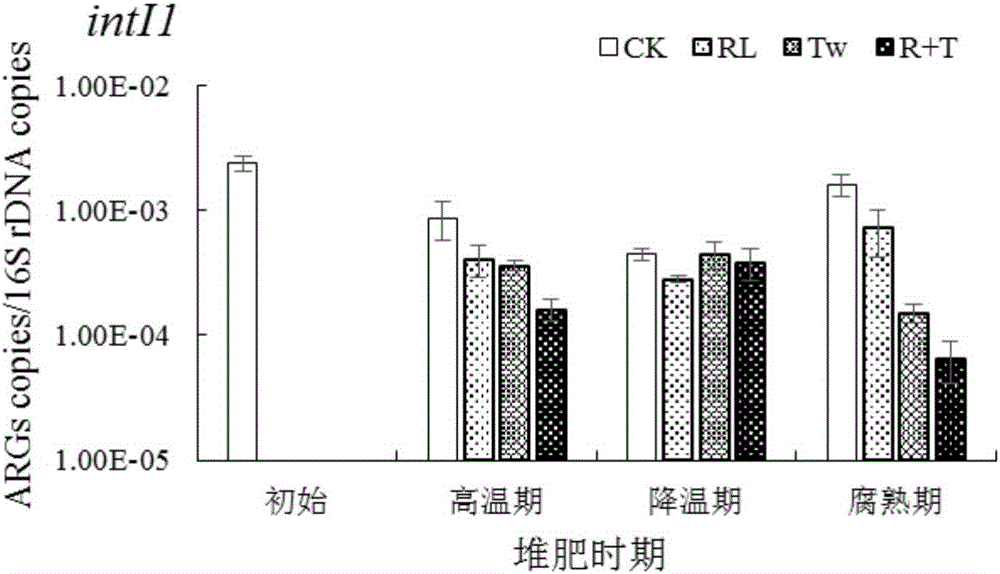Method for reducing macrolide resistance gene and intI1 abundance in chicken manure compost
A resistance gene and composting technology, which is applied in the field of farm solid waste treatment, can solve the problem that the impact of ARGs has not been reported, and achieve the effects of shortening the compost maturity period, easily obtaining raw materials, and facilitating degradation.
- Summary
- Abstract
- Description
- Claims
- Application Information
AI Technical Summary
Problems solved by technology
Method used
Image
Examples
Embodiment 1
[0026] Example 1: Effects of Surfactants on the Abundance of Macrolide Resistance Genes (ermB, ermF, ermX, ermQ)
[0027] Mix the fresh chicken manure with the crushed wheat straw evenly, and adjust the initial C / N ratio to about 30:1. One part uses 0.15% rhamnolipid aqueous solution (RL) to adjust the initial water content of 55% to 60%, one part uses 0.15% Tween 80 (Tw) to adjust the water content to 55% to 60%, and one part uses 0.15% The rhamnolipid and Tween 80 mixed solution (R+T) is used to adjust the water content to 55%-60%. Fully mix the stacked material and put it into a plastic foam box with a volume of 31cm×28cm×52cm and a wall thickness of 5cm. Stack it for 30 days, and turn it regularly to ensure sufficient oxygen. A total of 3 repetitions were set. Use distilled water to adjust the initial moisture content as a control.
[0028] Depend on figure 1 It can be seen that the addition of surfactants can reduce the abundance of macrolide (ermF, ermX, ermX) resist...
Embodiment 2
[0029] Example 2: Effect of surfactants on intI1 abundance
[0030] Mix fresh chicken manure with crushed wheat straw and adjust the initial C / N ratio to about 30:1. One part uses 0.15% rhamnolipid aqueous solution (RL) to adjust the initial water content of 55% to 60%, one part uses 0.15% Tween 80 (Tw) to adjust the water content to 55% to 60%, and one part uses 0.15% The rhamnolipid and Tween 80 mixed solution (R+T) is used to adjust the water content to 55%-60%. Fully mix the stacked material and put it into a plastic foam box with a volume of 31cm×28cm×52cm and a wall thickness of 5cm. Stack it for 30 days, and turn it regularly to ensure sufficient oxygen. A total of 3 repetitions were set. Use distilled water to adjust the initial moisture content to 55%-60% as a control.
[0031] Depend on figure 2 It can be seen that the addition of surfactant treatment can reduce the abundance of intI1 in chicken manure compost. Among them, the mixed addition of the two surfacta...
PUM
 Login to View More
Login to View More Abstract
Description
Claims
Application Information
 Login to View More
Login to View More - R&D
- Intellectual Property
- Life Sciences
- Materials
- Tech Scout
- Unparalleled Data Quality
- Higher Quality Content
- 60% Fewer Hallucinations
Browse by: Latest US Patents, China's latest patents, Technical Efficacy Thesaurus, Application Domain, Technology Topic, Popular Technical Reports.
© 2025 PatSnap. All rights reserved.Legal|Privacy policy|Modern Slavery Act Transparency Statement|Sitemap|About US| Contact US: help@patsnap.com


